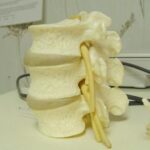Any joint replacement can be a daunting idea for non-physicians. It has always been thought of as a major surgery, often interrupting daily life for a minimum of 3 months. The result of which was iffy – sometimes limited motion or pain would still be present. And the traditional artificial joints were reputed to last an average ten-fifteen years (with the max estimate being twenty years). The knee joint is one of the largest and most injured joints in the body, according to the
Dartmoth-Hitchcock Medical Center.(1)
Don’t lose hope!! The development of new surgical techniques and artificial joint materials has grown by leaps and bounds over the last decade. Now, your surgeon has the choice of no less than 6 different artificial joints and partial joints. Saddly, this doesn’t make the choice any less confusing for the patient.
Understanding The Anatomy Of The Knee:
The knee is made up 3 bones: the end of the thigh bone (the femur), that rotates over the top of the shin bone (the tibia), and the knee cap (the patella) that slides into a groove on the end of the femur.
The knee also comprises 4 main ligaments, each responsible for a different motion of the leg: The ACL (Anterior Curiate Ligament) this ligament cris-crosses with the PCL, connecting the Frmur to the Tibia. It’s purpose is to stabilize the knee preventing the tibia from lateral movement without the femur also moving, The PCL (Posterior Curiate Ligament) serves the same purpose. The ACL and PCL also control forward motion of the tibia – straightening the leg.. The MCL (Medial Collateral Ligament) is located on the inside of the knee. Its purpose is to keep the knee joint from collapsing backward, it also controls the rotation of the lower leg – pointing the foot from side to side. Finally the Patellar Ligament/Tendon extends from the quadracep (thigh muscle) to the knee cap then on to the tibia (it is conscidered both a ligament and tendon because it connects both bone-to-bone and muscle-to-bone).
Two final contributing factors to a healthy knee are the Meniscus and the Bursae. The Meniscus is a c-shaped This is a c-shaped cartilage sack that acts as a cushion between the femur and the tibia. There are two in the knee joint – one toward the outside and one toward the inside of the knee joint. The Bursae This is a small sack of viscous fluid located under the knee cap, to keep it from rubbing against the femur and tibia.
Total Knee Replacement:
A Total Knee Replacement (TKR) is defined by The Dartmoth-Hitchcock Medical Center, as an invasive surgical procedure. That has benefited “thousands of people.”
Those who are eligable for a TKR:
*Knee pain that has failed to respond to conservative therapy (including medication, injections, and physical
therapy for 6 months or more)
*Knee pain that limits or prevents activities of importance to the patient
*Arthritis of the knee
*Decreased knee function caused by arthritis
*Inability to sleep through the night because of knee pain
*Some tumors involving the knee
Surgical Components:
TKR involve the surgeon removing the damaged surfaces of the 3 bones of the knee, and covering them with smooth metal surfaces and plastic implants. Accordint to Zimmer (an Orthopedic company out of the UK), the Femur is replaced with a rounded metal component that comes very close to matching the curve of your natural bone. The surface of the Tibia is replaced with a flat metal component and a slab of ultra-high-molecular weight polyethylene plastic to serve as the cartilage, or the entire component may be plastic. The undersurface of the patella also may be replaced with a round disc made of the same polyethylene plastic.
Physio-Therapy: begins in hospital within 24 – 48 hrs post-surgery
Benefits of TKR:
According to MedSolution.com(2), a person who selects total knee replaceemtn can look forward to the ability to resume almost all pre-injury activities, includine sports, with little to know discomfort and little to know loss of knee stability.
Risks of TKR:
TKR is a major surgery, and therefore a patient faces the same risks as all otehr major operations, including (but
not limited to):
* Deep Vein Thrombosis – This risk of clot formation in leg veins can be minimized by giving blood thinning medication after Total Knee Replacement surgery.
Infection – The risk of infection is less than 1% and pre-operative antibiotics are given to prevent this from happening.
* Pain and Stiffness – Occasionally this problem occurs if you are significantly overweight or have diabetes. This may require a manipulation under anesthesia or a revision surgery.
* Nerve and vessel damage – It is unlikely that any major nerve or vessel will be damaged the total knee replacement procedure. It is, however, very common to have a small area of numbness over the outer side of your knee where a superficial skin nerve is always cut during the surgery.
* Failure of plastic prosthesis – The prosthesis may fail due to the plastic wearing out and it may require revision.
* Excessive leeding and fluid build up around the joint – This may require drainage or may settle spontaneously.
* Excessive scarring – Some skin will scar up significantly at the site of incision.
– MedSolution.com (2)
*NOTE: Some doctors and medical centers offer a minimially inacive TKR which used computer models to guide the
replacement of the knee surfaces, making the need for the usual 8 – 12 inch incision redundant. The minimal invacive
procedure calls for an averace of under 14 cm for the incision. Speak with your orthopedic surgeon about this new
option.
Partial Knee Replacement:
Partial Knee Replacement (called UNI-compartmental Knee Replacement) is a minimally invasive surgery. The difference between the UNI and the TKR is the fact that only the damaged bones in the knee are resurfaced – as opposed to all of the bones being resurfaced in the TKR. Unicompartmental knee replacements involve smaller incisions, less bleeding, quicker recovery, and less bone loss than a total knee replacement, according to Sinai Hospital. (7)
Those Eligable for the UNI:
Patients who have arthritis that had failed to damage the entire knee are teh only ones eligable for the UNI. There must be parts of the knee (femor, tibia or patella) that have not yet been damaged. It is most beneficial to those whose arthritis is confined to a specific portion of hte knee joint.
Surgical Components:
Partial knee replacement is an option for patients who do not require total knee replacement because some of the joint surfaces are still healthy. In partial knee replacement surgery, the surgeon removes only the diseased portion of the knee before placing the implant, leaving the healthy portion untouched. This means that the surfaces are replaced on only one side of the joint, that is, only one of the rounded projections is replaced beneath it. As only the problem areas are under conscideration – they are accessed through a 3 – 4 inch incision. (2) The end of the femur and the tibia that is affected will be replaced – much the same as the TKR only the areas are limited.
Benefits & Risks of UNI:
Are the same as with TKR. The only difference being a smaller risk of infection as the inciscion site is smaller. BUT, that totally depends on the part of the knee needing replacement. According to Ortheopedics.com (3) some UNI are no more than a re-treading of the existing knee, that changes all benefits and risks.
Alternatives:
Two commonly used are Synvisc and Cortosone as well as NSaids (or anti-inflammatories).
Synvisc:
According to Synvisc.com (4) , Synvisc is used to relieve knee pain due to osteoarthritis (OA). It is for patients who do not get enough relief from simple painkillers such as acetaminophen, or from exercise and physical therapy. SYNVISC is generally well tolerated. However, it may not work for everyone. The side effects most commonly seen when SYNVISC is injected into the knee were pain, swelling and/or fluid buildup around the knee. Cases where the swelling is extensive or painful should be discussed with your doctor. Other side effects such as rash have been reported rarely. Before trying SYNVISC, tell your doctor if you are allergic to products from birds-such as feathers, eggs or poultry-or if your leg is swollen or infected. Talk to your doctor before resuming strenuous weight-bearing activities after treatment. SYNVISC has not been tested in children, pregnant women or women who are nursing. You should tell your doctor if
you think you are pregnant or if you are nursing a child. Synvisc is a gel-like mixture that is made up of hylan A fluid, hylan B gel, and salt water. Hylan A and hylan B are made from a substance called hyaluronan (pronounced hye-a-loo-ROE-nan), also known as sodium hyaluronate that comes from chicken combs. This is a natural substance found in the body and is present in very high amounts in joints. The body’s own hyaluronan acts like a lubricant and a shock absorber in the joint and is needed for the joint to work properly.
Generally Synvisc lasts for a minimum of 2 years
Cortosone:
According to MedicineNet.com (5) Corticosteroids are a class of medications that are related to cortisone. Medications of this class reduce inflammation powerfully. They are used to reduce inflammation caused by a variety of diseases. Cortisone is one type of corticosteroid. Corticosteroids are not pain relievers. They reduce inflammation. When corticosteroids relieve pain it is because they have reduced inflammation. While the inflammation for which
corticosteroids are given can recur, corticosteroid injections can provide months to years of relief when used properly. Cortisone injections can be administered easily in the doctor’s office. Other advantages include the rapid onset of the medication’s action, dependability, and minimal side effects. Another distinct benefit of a corticosteroid injection is that the relief of localized inflammation in a particular body area is more rapid and powerful than with traditional anti-inflammatory medications given by mouth such as aspirin. A single injection also can avoid certain side effects, notably irritation of the stomach, that accompany many oral anti-inflammatory medications.
Nsaids:
NSAID stands for Non-Seroidal Ainti-Inflammatory Drugs. Nonsteroidal anti-inflammatory drugs (NSAIDs) block the Cox enzymes and reduce prostaglandins throughout the body. As a consequence, ongoing inflammation, pain, and fever are reduced. Since the prostaglandins (which promote inflammation and pain) that protect the stomach and support the platelets and blood clotting also are reduced, NSAIDs can cause ulcers in the stomach and promote bleeding. NSAIDs differ in how strongly they inhibit Cox-1 (an enzyme) and, therefore, in their tendency to cause ulcers and promote bleeding, therefore if you have riskfactors for either be sure to discuss with your physician. (6)
References:
(1) http://www.dartmouth-hitchcock.org/webpage.cfm?site_id=1&org;_id=1&utility;_id=46&fuseaction;=search_dhc&orig;_site=D-H&enable;_spell=1&ALLDH;=1&qt;=Total+Knee+Replacement , 2007 Dartmoth-Hitchcock Medical Center, Concord
(2) http://www.medsolution.com/content/surgery_orthopedic-UKR.asp#whatis , 2005 Medical Tourism Inc, MEDSOLUTION #2001-7495 132nd Street
Surrey, British Columbia, CANADA V3W 1J8
(3) http://www.orthopaedics.com/uniknee.html , co Your Practice Online
(4) http://www,synvisc,com/ , 2005 – 2007 Genzyme Corporation. SYNVISC and GENZYME are registered trademarks of Genzyme Corporation
(5) http://www.medicinenet.com/ , Medical Author: William C. Shiel Jr., MD, FACP, FACR
(6) http://www.medicinenet.com/nonsteroidal_antiinflammatory_drugs/article.htm , written by Omudhome Ogbru, Pharm.D.,
Medical Editor: Jay W. Marks,M.D., 1996-2007 MedicineNet, Inc
(7) http://www.lifebridgehealth.org/body_rubin.cfm?id=4055 ,



